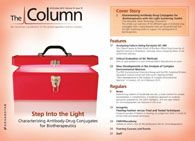Sample Amount Normalization in Metabolomics
A simple dansylation metabolite assay (DMA) for sample normalization that is similar to the bicinchoninic acid (BCA) protein assay widely used in proteomics has been presented in the journal Analytical Chemistry. The DMA assay is performed following sample extraction to determine the total metabolite concentration, which can then be used to determine the volume of sample needed to ensure that all samples contain the same concentration of metabolites.
Photo Credit: Mando19/Getty Images

A simple dansylation metabolite assay (DMA) for sample normalization that is similar to the bicinchoninic acid (BCA) protein assay widely used in proteomics has been presented in the journal Analytical Chemistry.1 The DMA assay is performed following sample extraction to determine the total metabolite concentration, which can then be used to determine the volume of sample needed to ensure that all samples contain the same concentration of metabolites.
The field of metabolomics links changes in the chemical signatures of biological tissue to alterations in metabolic processes that can be associated with disease. Determining changes in the metabolic profile of disease can aid drug discovery in the pharmaceutical industry, and enable accurate diagnosis of patients in the clinic. Regardless of the application or sample under study, successful metabolomics analysis is dependent on ensuring that the concentration of metabolites is the same in samples that are undergoing direct comparison. Corresponding author of the study Liang Li told The Column: “While we strive to develop and apply analytical tools for precise and accurate measurement of absolute concentration of a metabolite in a sample or relative concentration of a metabolite in two or more comparative samples, using a proper sampling technique is also extremely important as it can introduce artifacts. We cannot just take the same volume or same
weight of samples for analysis.”
The authors had previously published a sample normalization method performing liquid chromatography–ultraviolet (LC–UV) to quantify metabolites labelled with 12C-danyl chloride; however, the cost per analysis was too great.2 In this new study, the authors demonstrated how the same method could be used but with a microwell plate reader opposed to an LC–UV system. Two different strains of E.coli were subjected to dansylation labelling of metabolites, the labelled metabolites were subsequently extracted using ethyl acetate, and the UV absorbance of each sample was measured using a microwell plate reader. The absorbance of each of the metabolites was determined and compared with the absorption of known standards to give absolute concentrations. This allowed the sample volume to be adjusted according to the concentration of metabolites in the sample. Li commented: “The main advantage is that DMA is universally applicable. It is not restricted to a certain type of samples. It can be applied to biofluids such as urine, sweat, and saliva, cell and tissue extracts, plant extract, juice, wine, etc. The assay is also very simple to perform. And it uses a microplate reader, which is widely used for quantifying DNA and proteins. With DMA, we can now use the microplate reader to gauge the total metabolite concentration in a sample.” — B.D.
References
Y. Wu and L. Li, Analytical Chemistry 86, 9428–9433 (2014).
Y.M. Wu and L. Li, Analytical Chemistry84, 10723–19731 (2012).
This story originally appeared in The Column. Click here to view that issue.

This information is supplementary to the article “Accelerating Monoclonal Antibody Quality Control: The Role of LC–MS in Upstream Bioprocessing”, which was published in the May 2025 issue of Current Trends in Mass Spectrometry.
Investigating the Protective Effects of Frankincense Oil on Wound Healing with GC–MS
April 2nd 2025Frankincense essential oil is known for its anti-inflammatory, antioxidant, and therapeutic properties. A recent study investigated the protective effects of the oil in an excision wound model in rats, focusing on oxidative stress reduction, inflammatory cytokine modulation, and caspase-3 regulation; chemical composition of the oil was analyzed using gas chromatography–mass spectrometry (GC–MS).












